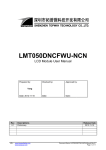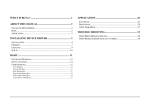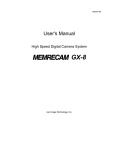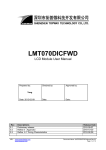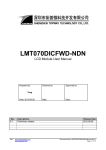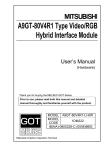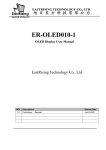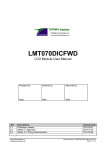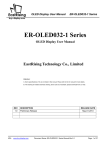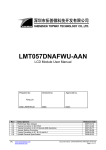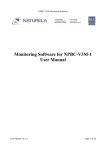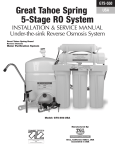Download LMT056DIDFWD-ABB - topwaydisplay.com
Transcript
LMT056DIDFWD-ABB LCD Module User Manual Prepared by: Checked by: Approved by: Date: Date: Yang Date: 2012-11-08 Rev. 0.1 0.2 0.3 URL: Descriptions Preliminary new release Add on Touch Panel Controller Typing Correction on Terminal Function www.topwaydisplay.com www.topwaysz.com Release Date 2012-08-01 2012-11-08 2012-11-15 Document Name: LMT056DIDFWD-ABB-Manual-Rev0.3 Page: 1 of 14 TOPWAY LCD Module User Manual LMT056DIDFWD-ABB Table of Content 1. Product Highlight................................................................................................................... 3 2. Block Diagram........................................................................................................................ 3 3. Terminal Function (Input Terminal) ...................................................................................... 4 4. Absolute Maximum Ratings .................................................................................................. 5 5. Electrical Characteristics ...................................................................................................... 5 5.1 6. DC Characteristics ................................................................................................................................................. 5 AC Characteristics................................................................................................................. 6 6.1 TFT Controller Timing Characteristics.................................................................................................................... 6 6.2 TFT Controller Reset Timing.................................................................................................................................. 7 7. Optical Characteristics .......................................................................................................... 8 8. Function Specifications......................................................................................................... 9 8.1 9. TFT Controller Functions ....................................................................................................................................... 9 Precautions of using LCD Modules .................................................................................... 13 10. Appendix <Inspection items and criteria for appearance defect>................................... 14 URL: www.topwaydisplay.com www.topwaysz.com Document Name: LMT056DIDFWD-ABB-Manual-Rev0.3 Page: 2 of 14 TOPWAY LCD Module User Manual LMT056DIDFWD-ABB 1. Product Highlight Power Supply and logic level - 5.0V supply - 3.3V logic level(tolerate 5.0V input) Display - TFT LCD display - 640 x 480 pixels - 65536colors - data refresh rate 20fps possible Host Interface - 8bit data, 1bit address, 8080mode - fast command execution Built-in Drawing Engine - Hardware rotation of 0°,90°,180°,270° - Hardware Display Mirroring - Hardware Windowing - Address auto increment Backlight Control - 256 level backlight brightness control Touch Panel - 4 wire resistive touch panel General Specification beat Signal Interface : Display Technology : Display Mode : Screen Size(Diagonal) : Outline Dimension : Active Area : Number of dots : Pixel Pitch : Pixel Configuration : Backlight : Color Depth: Surface Treatment: Viewing Direction : Operating Temperature : Storage Temperature : 8bit data, 1bit address TFT active matrix Transmissive / Normal White 5.6” 155.2 x 109.0 x 14.2 (mm) (see attached drawing for details) 112.896 x 84.672 (mm) 640 x 3 (RGB) x 480 0.0588 x 0.1764 (mm) RGB Stripe LED 1677216(24bit)colors Anti-Glare Treatment 12 o’ clock -20 ~ +70°C -30 ~ +80°C 2. Block Diagram D0~D7 /RESET, TE VDD, VSS URL: www.topwaydisplay.com www.topwaysz.com Touch Panel Backlight Driver Backlight Gate Driver /RD, /WR, /CS, D/C TP controller AD7843 TFT controller SSD1963 DIN, DOUT, DCLK /PENIRQ, BUSY, /CSTP Power Circuit 5.6”TFT Panel Source Driver Document Name: LMT056DIDFWD-ABB-Manual-Rev0.3 Page: 3 of 14 TOPWAY LCD Module User Manual LMT056DIDFWD-ABB 3. Terminal Function (Input Terminal) No. Pin Name 1 VSS 2 3 VDD 4 5 D/C 6 /CS 7 /RESET 8 : 15 16 17 18 19 20 21 22 23 24 25 26 27 28 D0 : D7 TE /RD /WR NC NC /PENIRQ DOUT BUSY DIN /CSTP DCLK NC VSS I/O Descriptions P Power Supply GND (0V) I Positive Power Supply (5.0V) Register Select I D/C=0, command D/C=1, data or parameter I Chip Select signal Reset signal, I /RESET=1, normal /RESET=0, reset execute I/O 8bit Data bus O I I I O O I I I P Tear Signal (*1) Read Status signal Write signal No Connection No Connection Pen Interrupt (*2) Data Output Busy Output Data Input Chip Select, also for initiating the conversions Clock Input for Serial Data & conversions No Connection Power Supply GND (0V) Note. *1. Tear signal may leave open when not use *2. Pulled-up by internal resistor URL: www.topwaydisplay.com www.topwaysz.com Document Name: LMT056DIDFWD-ABB-Manual-Rev0.3 Page: 4 of 14 TOPWAY LCD Module User Manual LMT056DIDFWD-ABB 4. Absolute Maximum Ratings Items Power Supply voltage Backlight Supply voltage Operating Temperature Storage Temperature Symbol VDD VDD_BL TOP TST Min. -0.3 -0.3 -20 -30 Max. 6.0 6.0 70 80 Unit V V C C Condition No Condensation No Condensation Note: *1. This rating applies to all parts of the module. And should not be exceeded. *2. The operating temperature only guarantees operation of the circuit. The contrast, response speed, and the other specification related to electro-optical display quality is determined at the room temperature, TOP=25℃ *3. Ambient temperature when the backlight is lit (reference value) *4. Any Stresses exceeding the Absolute Maximum Ratings may cause substantial damage to the device. Functional operation of this device at other conditions beyond those listed in the specification is not implied and prolonged exposure to extreme conditions may affect device reliability. 5. Electrical Characteristics 5.1 DC Characteristics Items Power Supply Voltage Input logic high voltage Input logic low voltage Output logic high voltage Output logic low voltage Logic Supply Current (VDD) Symbol VDD VIH VIL VOH VOL IDD Min. 4.8 3.0 0 3.0 0 - Typ. 5.0 380.0 250.0 VDD =5.0V,Top=25℃, VSS=0V Unit Remark V *2 V *2, *3 V *2, *3 V *2, *3 V *2, *3 mA Backlight (100%PWM) mA Backlight (66%PWM) Max. 5.5 VDD 0.6 3.6 0.6 - Note: *1. Never Apply logic signal before the VDD supply. *2. VDD setting should match the signals voltage *3. For all the inputs signals *4. PLL Clock Freq=200MHz 5.2 Touch Panel Characteristics Items Operating Force Life Time Symbol Fop TL MIN. 60 - TYP. 1,000,000 MAX. 100 - Unit g times TOP =25C Applicable Pin - Cautions: Exceeding the recommended Condition could cause substantial damage to the touch panel and shorten its lifetime. YX+ Y+ X- URL: www.topwaydisplay.com www.topwaysz.com Document Name: LMT056DIDFWD-ABB-Manual-Rev0.3 Page: 5 of 14 TOPWAY LCD Module User Manual LMT056DIDFWD-ABB 6. AC Characteristics 6.1 TFT Controller Timing Characteristics 8080 Mode Write Timing 8080 Mode Read Timing VSS=0V, VDD=5.0V, TOP=25C Item System Clock Period(*1) Control Pulse High Width Write Read Control Pulse Low Width Write (next write cycle) Write (next read cycle) Read Address Setup Time Address Hold Time Write Data Setup Time Write Data Hold Time Write Low Time Read Data Hold Time Access Time Read Low Time Rise Time Fall Time Chip select setup time Chip select hold time to read signal Symbol tMCLK tPWCSL tPWCSH tAS tAH tDSW tDHW tPWLW tDHR tACC tPWLR tR tF tCS tCSH MIN. 1/fMCLK TYP. - MAX. - Unit ns 29 1.5*tMCLK - ns 51 1.3*tMCLK - ns 29 1.5*tMCLK - ns 113 113 7.8 9 11.5 7.8 28 9.1 63.3 58 9 9 9*tMCLK 9*tMCLK - 0.4 0.4 - ns ns ns ns ns ns ns ns ns ns ns ns ns ns Note: *1. tMCLK is the System Clock Period, which may config by internal PLL setting *2. LMT056DIDFWD is driving by external 10MHz, and clock up by enabling the SSD1963 internal PLL *3. Suggested PLL clock setting is 200MHz URL: www.topwaydisplay.com www.topwaysz.com Document Name: LMT056DIDFWD-ABB-Manual-Rev0.3 Page: 6 of 14 TOPWAY 6.2 Symbol trs trst trh VSS=0V, VDD=5.0V, TOP=25C TYP. MAX. Unit ms ms ms MIN. 2 0.2 2 Touch Panel Controller Timing Characteristics Item Acquisition Time DIN Valid Prior to DCLK Rising DIN Hold After DCLK HIGH DCLK Falling to DOUT Valid /CS_TP Falling to DOUT Enabled /CS_TP Rising to DOUT Disabled /CS_TP Falling to First DCLK Rising /CS_TP Rising to DCLK Ignored DCLK HIGH DCLK LOW DCLK Falling to BUSY Rising /CS_TP Falling to BUSY Enabled /CS_TP Rising to BUSY Disabled URL: LMT056DIDFWD-ABB TFT Controller Reset Timing Item Reset setup time Reset pulse Reset hold time 6.3 LCD Module User Manual www.topwaydisplay.com www.topwaysz.com Symbol tACQ tDS tDH tDO tDV tTR tCSS tCSH tCH tCL tBD tBDV tBTR MIN. 1.9 125 13 125 10 250 250 - VSS=0V, VDD=3.3V, TOP=25C TYP. MAX. Unit us ns ns 250 ns 160 ns 250 ns ns ns ns ns 250 ns 160 ns 250 ns Document Name: LMT056DIDFWD-ABB-Manual-Rev0.3 Page: 7 of 14 TOPWAY LCD Module User Manual LMT056DIDFWD-ABB 7. Optical Characteristics Item Viewing angle (CR≥10) Response Time Contrast ratio Color chromaticlty Luminance Luminance uniformity Symbol Condition MIN. TYP. MAX. θL 9 o’ clock 60 70 - θR 3 o’ clock 60 70 - θT 12 o’ clock 40 50 - θB 6 o’ clock 60 70 - Tf - 10 20 msec Tr - 15 30 msec 400 500 - - 0.26 0.31 0.26 - WY 0.28 0.33 0.38 - L - 350 - cd/m YU 70 75 - % CR WX Normal o θ=0 UNIT Note. degree *2 *3 *1 2 *4 *4 Note: *1. Definition of Contrast Ratio The contrast ratio could be calculate by the following expression: Contrast Ratio (CR) = Luminanc with all pixels white / Luminance with all pixels black *2 Definition of Viewing Angle *3 Definition of response time *4 Definition of Luminance Uniformity Luminance uniformity (Lu)= Min. Luminance form pt1~pt9 / Max Luminance form Pt1~pt9 *5. Measured with TFT and backlight only URL: www.topwaydisplay.com www.topwaysz.com Document Name: LMT056DIDFWD-ABB-Manual-Rev0.3 Page: 8 of 14 TOPWAY LCD Module User Manual LMT056DIDFWD-ABB 8. Function Specifications 8.1 TFT Controller Functions 8.1.1 Display Memory Addressing TFT module with 640x480 pixels, using SSD1963, address the display memory with a co-ordinate system as follow. Display Window (0,0) 480 pixels (x1,y1) Window Frame (x2,y2) (639,479) 640 pixels 8.1.2 Command Packet - Command Packet organizes with “Command Code”followed by “Parameter” - Command Code and Parameters are 8bit only - Number of Parameters is depends on Command type some of the command followed with no parameter. Se q. 1 D/C /RD /WR Lo byte (D7:D0) 0 1 ↑ Command code 2 1 1 ↑ Parameter 1 3 1 1 ↑ Parameter 2 4 1 1 ↑ Parameter 3 : : : : : 8.1.3 Data Format - Display Data is in 24bit format (R:G:B=8:8:8) - 24bit data built one pixels - Display Data could be continue write (depends on command and configuration) URL: www.topwaydisplay.com www.topwaysz.com D/C /RD /WR D7 D6 D5 D4 D3 D2 D1 D0 1 1 ↑ R7 R6 R5 R4 R3 R2 R1 R0 1 1 ↑ G7 G6 G5 G4 G3 G2 G1 G0 1 1 ↑ B7 B6 B5 B4 B3 B2 B1 B0 1 1 ↑ R7 R6 R5 R4 R3 R2 R1 R0 1 1 ↑ G7 G6 G5 G4 G3 G2 G1 G0 1 1 ↑ B7 B6 B5 B4 B3 B2 B1 B0 : : : : : : : : : : : Document Name: LMT056DIDFWD-ABB-Manual-Rev0.3 Page: 9 of 14 TOPWAY 8.1.4 LMT056DIDFWD-ABB Command Table Code (hex) 0x00 0x01 0x0A 0x0B 0x0C 0x0D 0x0E 0x0F 0x10 Command nop soft_reset get_power_mode get_address_mode Reserved get_display_mode get_tear_effect_status Reserved enter_sleep_mode 0x11 exit_sleep_mode 0x12 0x13 0x20 0x21 0x26 0x28 0x29 0x2A 0x2B 0x2C enter_partial_mode enter_normal_mode exit_invert_mode enter_invert_mode set_gamma_curve set_display_off set_display_on set_column_address set_page_address write_memory_start 0x2E read_memory_start 0x30 0x33 0x34 set_partial_area set_scroll_area set_tear_off 0x35 set_tear_on 0x36 0x37 0x38 0x39 0x3A 0x3C set_address_mode set_scroll_start exit_idle_mode enter_idle_mode Reserved write_memory_continue 0x3E read_memory_continue Hex Code 0x44 0x45 0xA1 0xA8 URL: LCD Module User Manual Command set_tear_scanline get_scanline read_ddb Reserved www.topwaydisplay.com www.topwaysz.com Description No operation Software Reset Get the current power mode Get the frame buffer to the display panel read order Reserved The SSD1963 returns the Display Image Mode. Get the Tear Effect status Reserved Turn off the panel. This command will pull low the GPIO0. If GPIO0 is configured as normal GPIO or LCD miscellaneous signal with command set_gpio_conf, this command will be ignored. Turn on the panel. This command will pull high the GPIO0. If GPIO0 is configured as normal GPIO or LCD miscellaneous signal with command set_gpio_conf, this command will be ignored. Part of the display area is used for image display. The whole display area is used for image display. Displayed image colors are not inverted. Displayed image colors are inverted. Selects the gamma curve used by the display panel. Blanks the display panel Show the image on the display panel Set the column address Set the page address Transfer image information from the host processor interface to the SSD1963 starting at the location provided by set_column_address and set_page_address Transfer image data from the SSD1963 to the host processor interface starting at the location provided by set_column_address and set_page_address Defines the partial display area on the display panel Defines the vertical scrolling and fixed area on display area Synchronization information is not sent from the SSD1963 to the host processor Synchronization information is sent from the SSD1963 to the host processor at the start of VFP Set the read order from frame buffer to the display panel Defines the vertical scrolling starting point Full color depth is used for the display panel Reduce color depth is used on the display panel. Reserved Transfer image information from the host processor interface to the SSD1963 from the last written location Read image data from the SSD1963 continuing after the last read_memory_continue or read_memory_start Description Synchronization information is sent from the SSD1963 to the host processor when the display panel refresh reaches the provided scanline Get the current scan line Read the DDB from the provided location Reserved Document Name: LMT056DIDFWD-ABB-Manual-Rev0.3 Page: 10 of 14 TOPWAY 8.1.5 LCD Module User Manual LMT056DIDFWD-ABB Command Table(continue) Code (hex) 0xB0 0xB1 0xB4 0xB5 0xB6 Description Set the LCD panel mode and resolution Get the current LCD panel mode, pad strength and resolution Set front porch Get current front porch settings Set the vertical blanking interval between last scan line and next LFRAME pulse 0xB7 get_vert_period Set the vertical blanking interval between last scan line and next LFRAME pulse 0xB8 set_gpio_conf Set the GPIO configuration. If the GPIO is not used for LCD, set the direction. Otherwise, they are toggled with LCD signals. 0xB9 get_gpio_conf Get the current GPIO configuration 0xBA set_gpio_value Set GPIO value for GPIO configured as output 0xBB get_gpio_status Read current GPIO status. If the individual GPIO was configured as input, the value is the status of the corresponding pin. Otherwise, it is the programmed value. 0xBC set_post_proc Set the image post processor 0xBD get_post_proc Set the image post processor 0xBE set_pwm_conf Set the image post processor 0xBF get_pwm_conf Set the image post processor 0xC0 set_lcd_gen0 Set the rise, fall, period and toggling properties of LCD signal generator 0 0xC1 get_lcd_gen0 Get the current settings of LCD signal generator 0 0xC2 set_lcd_gen1 Set the rise, fall, period and toggling properties of LCD signal generator 1 0xC3 get_lcd_gen1 Get the current settings of LCD signal generator 1 0xC4 set_lcd_gen2 Set the rise, fall, period and toggling properties of LCD signal generator 2 0xC5 get_lcd_gen2 Get the current settings of LCD signal generator 2 0xC6 set_lcd_gen3 Set the rise, fall, period and toggling properties of LCD signal generator 3 0xC7 get_lcd_gen3 Get the current settings of LCD signal generator 3 0xC8 set_gpio0_rop Set the GPIO0 with respect to the LCD signal generators using ROP operation. No effect if the GPIO0 is configured as general GPIO. 0xC9 get_gpio0_rop Get the GPIO0 properties with respect to the LCD signal generators. 0xCA set_gpio1_rop Set the GPIO1 with respect to the LCD signal generators using ROP operation. No effect if the GPIO1 is configured as general GPIO. 0xCB get_gpio1_rop Get the GPIO1 properties with respect to the LCD signal generators. 0xCC set_gpio2_rop Set the GPIO2 with respect to the LCD signal generators using ROP operation. No effect if the GPIO2 is configured as general GPIO. Hex Code Command Description 0xCD get_gpio2_rop Get the GPIO2 properties with respect to the LCD signal generators. 0xCE set_gpio3_rop Set the GPIO3 with respect to the LCD signal generators using ROP operation. No effect if the GPIO3 is configured as general GPIO. 0xCF get_gpio3_rop Get the GPIO3 properties with respect to the LCD signal generators. 0xD0 set_dbc_conf Set the dynamic back light configuration 0xD1 get_dbc_conf Get the current dynamic back light configuration 0xD4 set_dbc_th Set the threshold for each level of power saving 0xD5 get_dbc_th Get the threshold for each level of power saving 0xE0 set_pll Start the PLL. Before the start, the system was operated with the crystal oscillator or clock input 0xE2 set_pll_mn Set the PLL 0xE3 get_pll_mn Get the PLL settings 0xE4 get_pll_status Get the current PLL status 0xE5 set_deep_sleep Set deep sleep mode 0xE6 set_lshift_freq Set the LSHIFT (pixel clock) frequency 0xE7 get_lshift_freq Get current LSHIFT (pixel clock) frequency setting 0xE8 Reserved Reserved 0xE9 Reserved Reserved 0xF0 set_pixel_data_interface Set the pixel data format of the parallel host processor interface 0xF1 get_pixel_data_interface Get the current pixel data format settings 0xFF Reserved Reserved Note. Please Refer to SSD1963 datasheet for details. URL: Command set_lcd_mode_ get_lcd_mode set_hori_period get_hori_period set_vert_period www.topwaydisplay.com www.topwaysz.com Document Name: LMT056DIDFWD-ABB-Manual-Rev0.3 Page: 11 of 14 TOPWAY LCD Module User Manual LMT056DIDFWD-ABB 8.1.6 Hardware Related Parameter Booster and Power circuit Internal DC-DC booster and Backlight driver are controlled by SSD1963 GPIO0 and GPIO1 respectively. It is necessary to enable them for normal operation via command Backlight Brightness PWM control It is suggested to config the backlight brightness control signal as 3kHz PWM signal for best performance. 8.1.7 Startup Program (Example) _RST=1; delayms(10); _RST=0; delayms(1); _RST=1; delayms(10); // wait for all power stable // reset pulse // wait till internal reset routine finish SdCmd(0xe2); SdData(0x3B); SdData(0x02); SdData(0x04); delayms(10); // config PLL to 200MHz SdCmd(0xe0); SdData(0x01); delayms(10); // enable PLL SdCmd(0xe0); SdData(0x03); delayms(10); // switch to use PLL clock SdCmd(0x11); SdCmd(0x13); SdCmd(0x20); SdCmd(0x38); // // // // exit_sleep_mode enter_normal_mode (exit_partial_mode) exit_invert_mode exit_idle_mode (using full color) SdCmd(0xB8); SdData(0x0f); SdData(0x01); SdCmd(0xba); SdData(0x01); delayms(10); SdCmd(0xba); SdData(0x03); delayms(10); // // // // // set_gpio_conf GPIO[0~3] controlled by host GPIO0 as normal GPIO GPIO[0~3]=0001, enable DC-CD booster GPIO[0~3]=0011, enable backlight booster SdCmd(0xf0); SdData(0x00); SdCmd(0xb0); SdData(0x24); SdData(0x20); SdData(0x02); SdData(0x7f); SdData(0x01); SdData(0xdf); // // // // // // set_pixel_data_interface (MCU) 8bit set_lcd_mode 24bit, disable FRC or dithering, DCLK=rising edge HSYNC=active lo, VSYNC=active low, default TFT m panel size 640-1 panel size 480-1 SdCmd(0xb4); SdData(0x03); SdData(0x1f); SdData(0x00); SdData(0x9f); SdData(0x07); SdData(0x00); SdData(0x00); SdData(0x00); // // // // // // set_hori_period total pluse per line, HT=800-1 horizontal front porch, HPS=160-1 HPW=0x07(default), not use LPS=0x0000(default), not use LPSPP=0x00(default), not use SdCmd(0xb6); SdData(0x02); SdData(0x0c); SdData(0x00); SdData(0x2c); SdData(0x01); SdData(0x00); SdData(0x00); // // // // // set_vert_period total line per frame, VT=525-1 vertical front porch, VPS=45-1 VPW=0x01(default), not use FPS=0x0000(default), not use SdCmd(0xe6); SdData(0x01); SdData(0xe0); SdData(0x00);// config PCLK=40ns(PLL@200MHz) SdCmd(0x36); SdData(0x00); // set_address_mode // top to bottom, left to right, RGB, normal SdCmd(0xbe); SdData(0x00); SdData(150); SdData(0x01); SdData(0xf0); SdData(0x00); SdData(0x00); // // // // // // // set_pwm_conf PWM clock set to 3kHz (PLL@200MHz) PWM width at about 60% (150/255) C[3]=0, non_DBC control; C[0]=1, enable PWM DBC manual level at middle DBC minimum lever at middle disable the DBC response delay setting SdCmd(0x29); // display on SdCmd(0x2c); SdData(0xff); SdData(0xff); SdData(0xff); SdData(0xff); SdData(0x00); SdData(0x00); .......... // // // // write_memory_start write a white pixel write a red pixel continue wirit display data Note. Above example program may need modification to fit correspondent application. URL: www.topwaydisplay.com www.topwaysz.com Document Name: LMT056DIDFWD-ABB-Manual-Rev0.3 Page: 12 of 14 TOPWAY LCD Module User Manual LMT056DIDFWD-ABB 9. Precautions of using LCD Modules Mounting - Mounting must use holes arranged in four corners or four sides. - The mounting structure so provide even force on to LCD module. Uneven force (ex. Twisted stress) should not applied to the module. And the case on which a module is mounted should have sufficient strength so that external force is not transmitted directly to the module. - It is suggested to attach a transparent protective plate to the surface in order to protect the polarizer. It should have sufficient strength in order to the resist external force. - The housing should adopt radiation structure to satisfy the temperature specification. - Acetic acid type and chlorine type materials for the cover case are not desirable because the former generates corrosive gas of attacking the polarizer at high temperature and the latter causes circuit break by electro-chemical reaction. - Do not touch, push or rub the exposed polarizers with glass, tweezers or anything harder than HB pencil lead. Never rub with dust clothes with chemical treatment. Do not touch the surface of polarizer for bare hand or greasy cloth.(Some cosmetics deteriorate the polarizer.) - When the surface becomes dusty, please wipe gently with absorbent cotton or other soft materials like chamois soaks with petroleum benzine. Normal-hexane is recommended for cleaning the adhesives used to attach front / rear polarizers. Do not use acetone, toluene and alcohol because they cause chemical damage to the polarizer. - Wipe off saliva or water drops as soon as possible. Their long time contact with polarizer Operating - The spike noise causes the mis-operation of circuits. It should be within the ± 200mV level (Over and under shoot voltage) - Response time depends on the temperature.(In lower temperature, it becomes longer.) - Brightness depends on the temperature. (In lower temperature, it becomes lower.) And in lower temperature, response time(required time that brightness is stable after turned on) becomes longer. - Be careful for condensation at sudden temperature change. Condensation makes damage to polarizer or electrical contacted parts. And after fading condensation, smear or spot will occur. - When fixed patterns are displayed for a long time, remnant image is likely to occur. - Module has high frequency circuits. Sufficient suppression to the electromagnetic interference shall be done by system manufacturers. Grounding and shielding methods may be important to minimized the interference Electrostatic Discharge Control Since a module is composed of electronic circuits, it is not strong to electrostatic discharge. Make certain that treatment persons are connected to ground through wrist band etc. And don’ t touch interface pin directly. Strong Light Exposure Strong light exposure causes degradation of polarizer and color filter. Storage When storing modules as spares for a long time, the following precautions are necessary. - Store them in a dark place. Do not expose the module to sunlight or fluorescent light. Keep the temperature between 5°C and 35°C at normal humidity. - The polarizer surface should not come in contact with any other object. It is recommended that they be stored in the container in which they were shipped. Protection Film - When the protection film is peeled off, static electricity is generated between the film and polarizer. This should be peeled off slowly and carefully by people who are electrically grounded and with well ion-blown equipment or in such a condition, etc. - The protection film is attached to the polarizer with a small amount of glue. If some stress is applied to rub the protection film against the polarizer during the time you peel off the film, the glue is apt tore main on the polarizer. Please carefully peel off the protection film without rubbing it against the polarizer. - When the module with protection film attached is stored for a long time, sometimes there remains a very small amount of glue still on the polarizer after the protection film is peeled off. - You can remove the glue easily. When the glue remains on the polarizer surface or its vestige is recognized, please wipe them off with absorbent cotton waste or other soft material like chamois soaked with normal-hexane. Transportation The LCD modules should be no falling and violent shocking during transportation, and also should avoid excessive press, water, damp and sunshine. URL: www.topwaydisplay.com www.topwaysz.com Document Name: LMT056DIDFWD-ABB-Manual-Rev0.3 Page: 13 of 14 TOPWAY LCD Module User Manual LMT056DIDFWD-ABB 10. Appendix <Inspection items and criteria for appearance defect> Bright/Dark Dots: Defect Type Specification Major Minor Bright Dots N≤ 2 ● Dark Dots N≤ 3 ● Total Bright and Dark Dots N≤ 4 ● Note: 1. The definition of dot: The size of a defective dot over 1/2 of whole dot is regarded as one defective dot. 2. Bright dot: Dots appear bright and unchanged in size in which LCD panel is displaying under black pattern. 3. Dark dot: Dots appear dark and unchanged in size in which LCD panel is displaying under pure red, green, blue pattern. URL: www.topwaydisplay.com www.topwaysz.com Document Name: LMT056DIDFWD-ABB-Manual-Rev0.3 Page: 14 of 14














